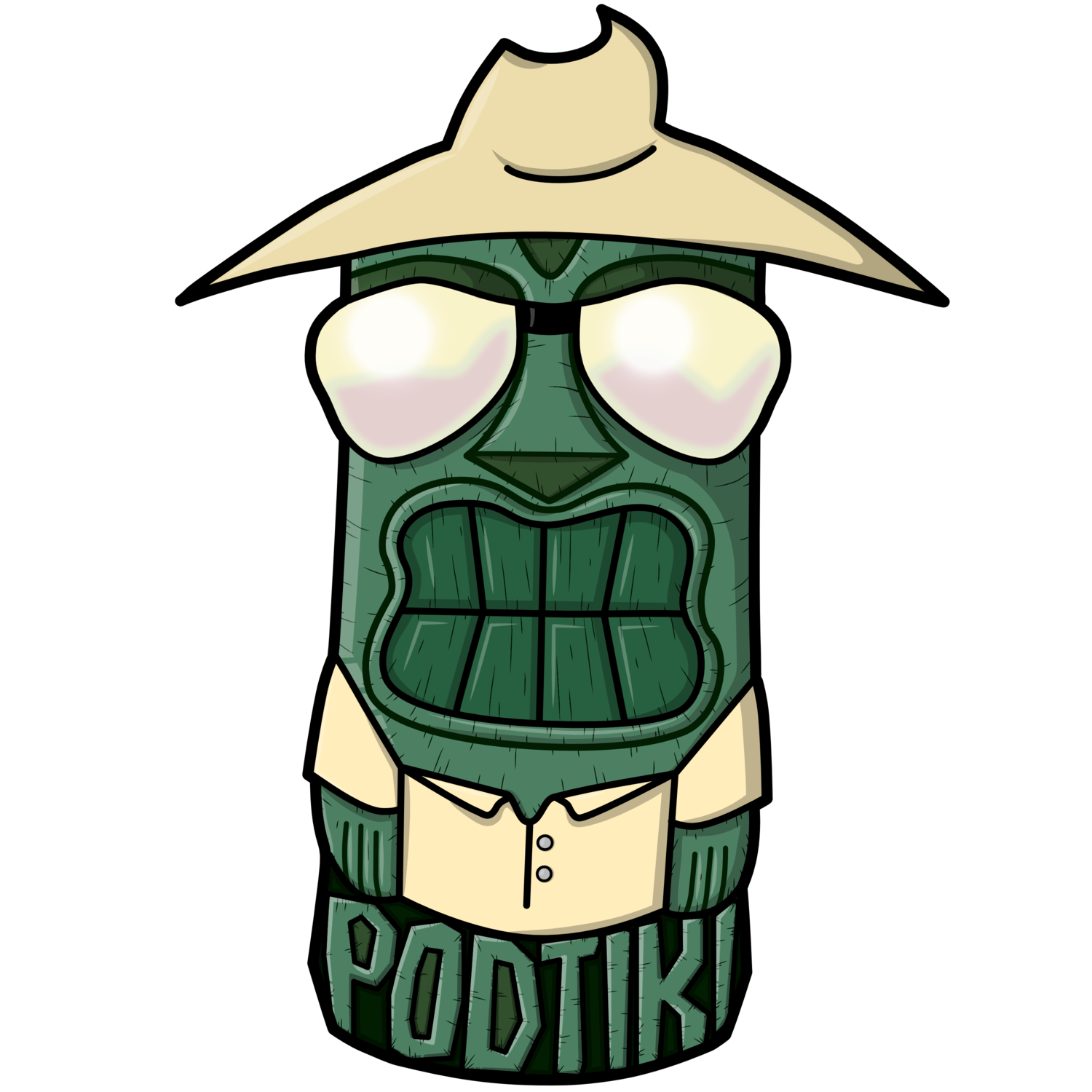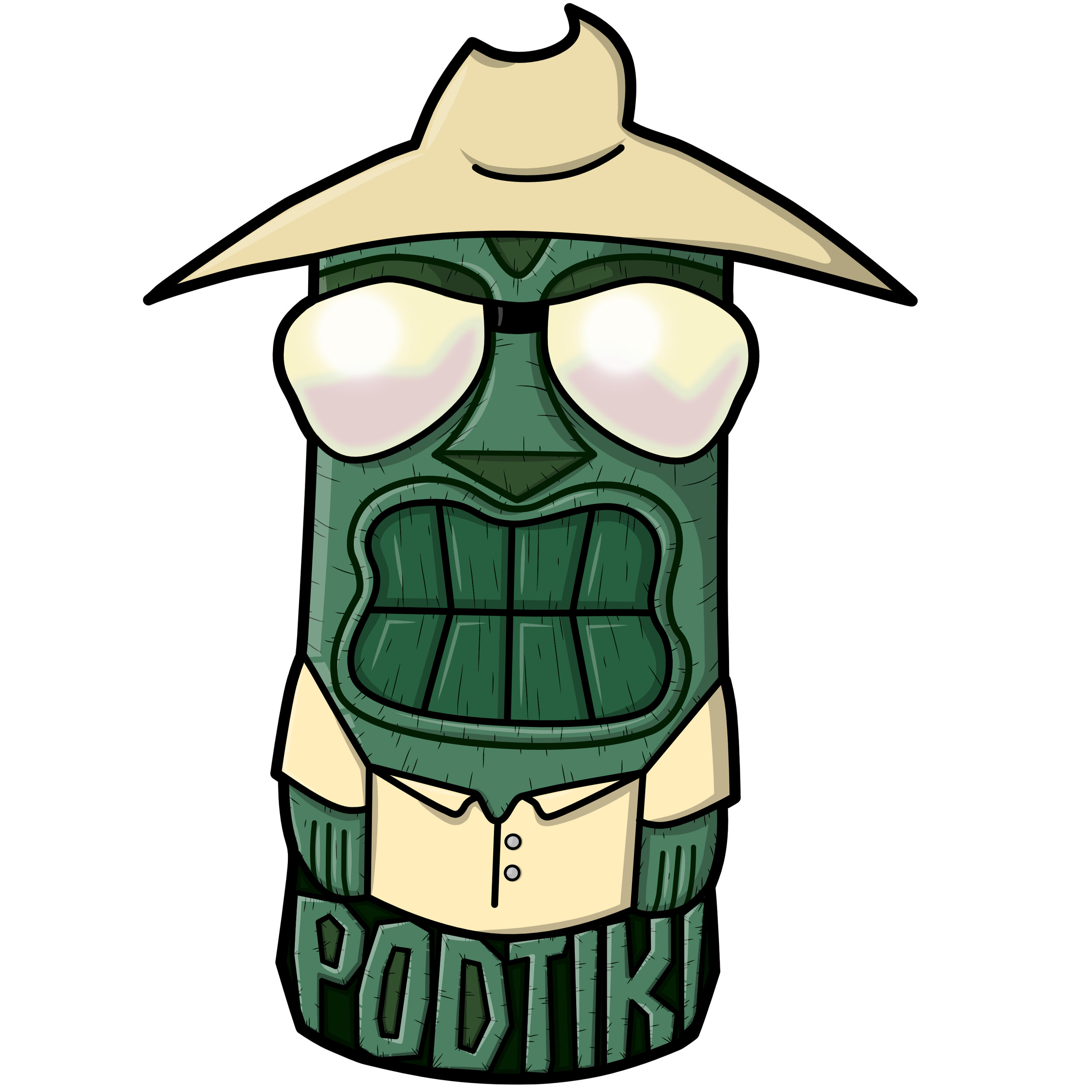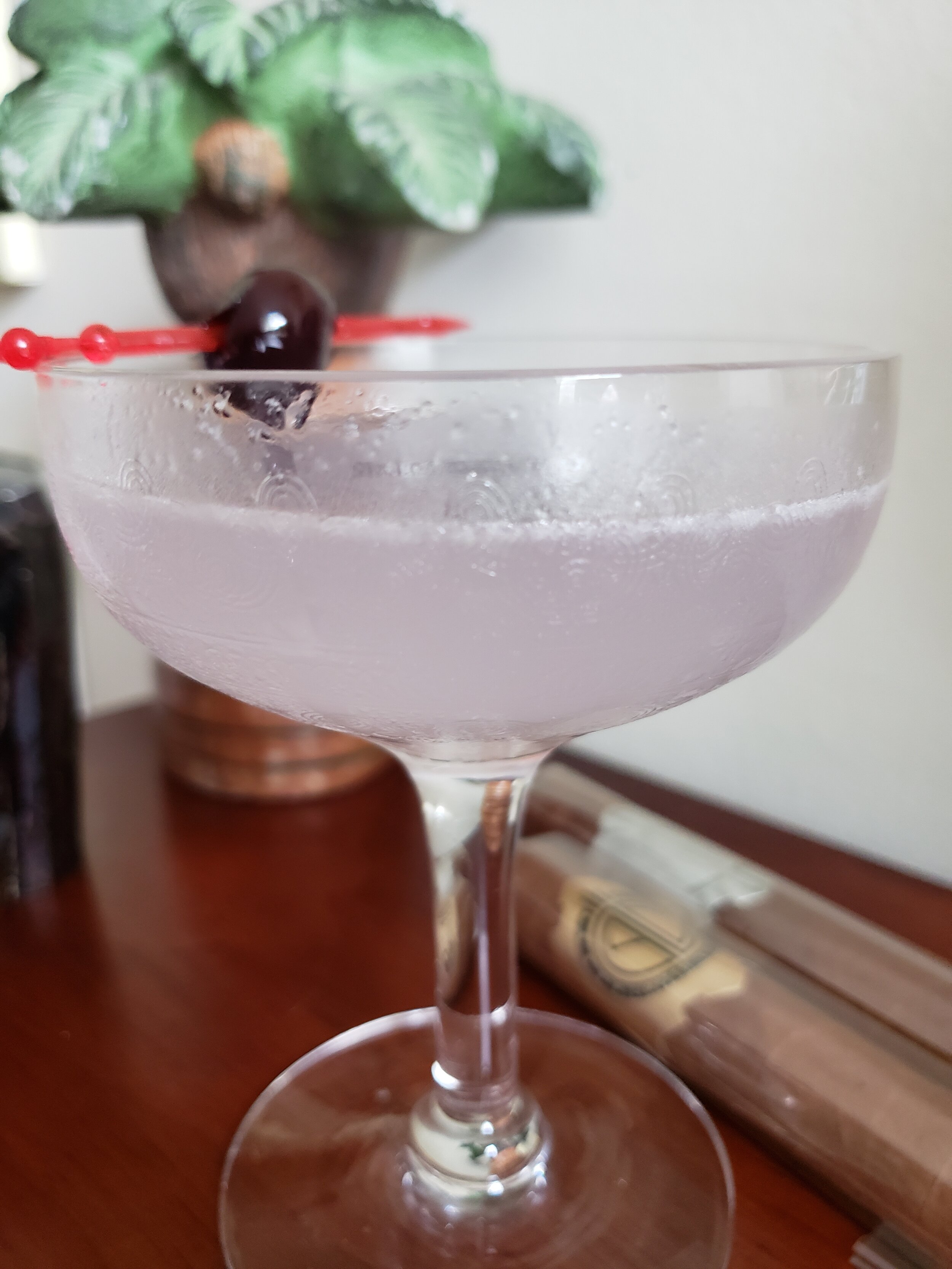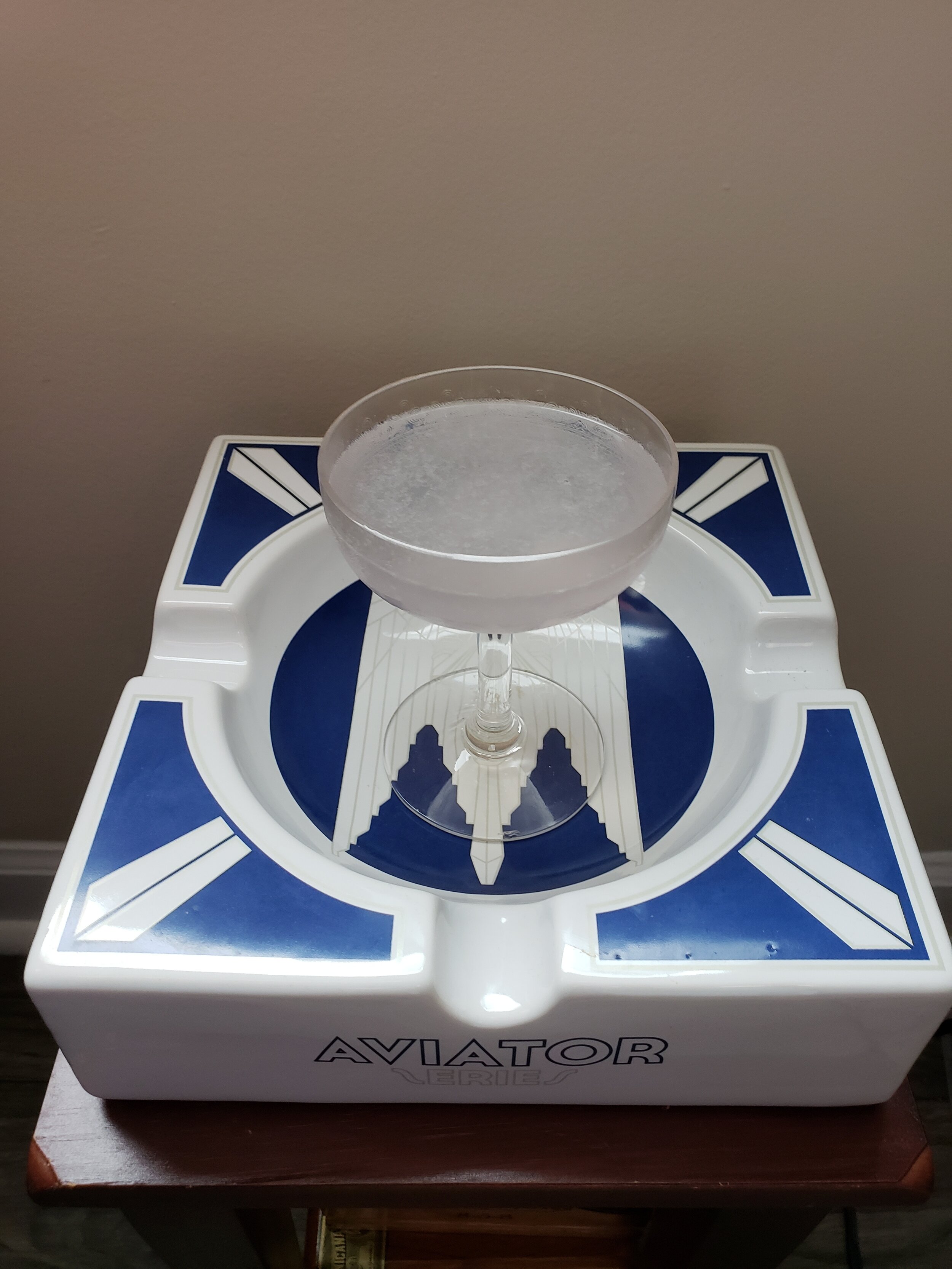Tiki is not simply just the object milieu we think of. Repugnant faced totems, hanging paper lanterns, thatched roofs, and Hawaiian print cabana shirts. Tiki is an idea that fantastical notions do exist. Exotic, erotic, quixotic jumbles of roar-splash-shake-shake-bubble-pop-ooh-la-la. We call it a form of escapism, but mankind longed for the luxury of modality centuries before the Marquesas ever canoed over to Hawaii, taking those lessons of Icarus and fashioning a way to discover the magic of the unknown.
What is magic but an abstract thought? When we find a way to transform abstract thought into reality we call it science. Our forebears' dreams, wild and untethered by the burdens of knowledge, blinked away on some ancient flaxen sunrise, become realized in our modern ho-hum-diddy-tomorrow-and tomorrow-and tomorrow creeping. The deliquescence of folly has left our dreams not full of unicorns and woodland nymphs, but binary code and artificial intelligence. Perhaps we should work on perfecting organic intelligence first.
But alas! There was a time in the not so long ago which was the province of both fantasy and technology. Industry and innovation in a time when the sky ceased to be the limit. Ladies and gentlemen, please return your seats and tray tables to their full upright position, make sure to grab a shaker and plenty of ice, hold back the urge to sexually harass your flight attendants because, after all, we’re going back to pre-prohibition and taking a flight of fancy with the Aviation cocktail.
^^^
By the dawn of the 20th century the U.S. stood in the aftermath of industrial revolution, upon the precipice of an history altering world war, and unfortunately - sort of, the intemperance movement. I say sort of because (hot take of the day!), Prohibition actually did a great job of culling the chaff for weird cocktails. Think of the Volstead Act like your Netflix algorithm for shitty drinks, weeding out the rom-coms so we can get to the next episode of Airbender. Ever had a drink called Conductor’s Eye Water? No? Well, you can thank prohibition for that, ‘cuz it’s gross.
The early 1900’s was a time of wonder, World’s Fairs, and testing the boundaries of what mankind could and would do for decades to come. Two of those visionaries were Orville and Wilber Wright. You may have heard of them. By 1905 the ol’ Wright bros had accomplished what many before said humans were never meant to do… fly. Subsequently making them the most prolific team of brothers in the 20th century outside of Mario and Luigi. But, of course, before we got to widespread advances in quality of life for all, flight was a nascent folly of the rich.
By mid-century Pan Am and the like had made air travel more attainable. Congruently the likes of Errol Fylnn made pencil thin mustaches more attainable while gracing the shores of burgeoning Caribbean getaways. Now when your head was in the clouds, your feet could follow. There remains always an air of luxury in flight, though. Pun intended. (Errol Flynn would be aghast at seeing how slovenly people dress at airports nowadays, and in place of an emotional support animal he would’ve brought along a questionably aged Hollywood mistress.)
Those swanky metal bullet passenger flights from the U.S. to the Caribbean greatly contribute to the inextricable link between aviation and Tikidom. Forever tethered by the bond of colonialism that clash of Americana and Caribbeana resulted in what would eventually serve as the basis of our beloved bacchanal. For a bit of a Pod Tiki Easter egg; my Grandpa was actually a bi-plane pilot. Although I never got to fly with him he bestowed upon me something that remains part of my style to this day. Old school Aviators, from a real pilot, gold wire frame and green teardrop lenses. Loops around the ears kept them from flying off in an open cockpit aircraft. His sunglasses on this small child’s face gave me great big bug eyes. It’s why I wear them today and it’s the reason the Pod Tiki logo is wearing Aviators.
Another boon of early Americana was cocktail culture. Before prohibition pseudo mixology was running rampant as flagpole sitting. (It’s a real thing. Look it up.) This led to some abominations, but a few strong swimmers persisted surviving not only Prohibition but well into our modern day coiffed bearded, derby hat wearing, I think these jeans are making me impotent, hipster laden speakeasy revivals. While the Daiquiri, Mojito, and Planter’s Punch were gathering speed in the Caribbean, and Mai Tai’s and Zombies captured the imagination of a post war generation, Sazerac’s kept court in the south. All the while our faithful standards held on for dear life, like Leonardo DiCaprio in Titanic. Old Fashioned, Manhattan, Negroni. These were genre defining cocktails. And no other represents the spirit of imagination, elucidation, and determination like the Aviation.
^^^
The Wallick Hotel in New York City. That’s where a German immigrant named Hugo Ensslin was head bartender in 1916 when he published the succinctly titled Recipes For Mixed Drinks. Not much is known about Ensslin’s life on this side of the bar, but he is credited as creating the Aviation cocktail as his book contains the first written recipe. Like in anything worth claiming there are some who argue of earlier versions but we end up with another situation of only so many ingredients and only so many combinations.
The power of marketing was not lost on enterprising bartenders of the day. Hugo Ensslin raised an eyebrow to people's fascination with these new fangled flying contraptions and created a drink to match the clear pale sky. Naming the Aviation was a no brainer.
Ensslin used Creme de Violette, a French liqueur made by flavoring base spirit with violet flower, to give his concoction it’s signature pastel hue. Adjusting the amount renders anything from cloudy opaque to straight up purple. This is redolent of how Harry Yee used Blue Curacao to match his Blue Hawaii to the color of the Pacific Ocean. Sadly by the 1930’s Creme de Violette was all but extinct in the U.S. The popular Savoy Cocktail Book by Harry Craddock omitted the Violette increasing some other ingredients adjusting the drink to the palate of the day. This kind of defeated the namesake and didn’t much differentiate the Aviation from a sweet Martini. In fact, as Ted Haigh points out in Vintage Spirits and Forgotten Cocktails, “substitute lime for the lemon and rum for the gin and you have a La Floridita Daiquiri.” (Link to Pod Tiki episode) Thus, the Creme de Violette is necessary to make a true Aviation.
Which brings us to my favorite part of the show. Because like Grandma always said, “never leave your teenage daughters unsupervised around Errol Flynn.” Oh, wait, wait. That’s not it. Oh, here it is. “Let’s make a drink!”
^^^
Gin tends to be pretty divisive. I don’t run into too many people who kinda like gin. Even among gin lovers the debate is always more vs less floral. Gin, much like rum, is a highly malleable spirit. I happen to enjoy a bright botanical gin heavy on juniper, but balanced. For this I prefer a classic London Dry Gin. Keep in mind London Dry denotes style, not provenance. A London Dry style gin can be produced anywhere.
I always made the mistake of believing gin was a Dutch invention. Apparently, its origins lay instead in Italy from where “monks and alchemists” spread throughout France and then the Netherlands. I love the idea of gin distillation being classified as alchemy. Take a whiff of some potent botanicals and one can understand why. Juniper based liquor did settle in the Netherlands where the Dutch made jenever from juniper berries and grains. Think, juniper moonshine. Juneshine. The british eventually began distilling jenever with any old raw material they could get their rosy noses into, mixing in new botanicals like anise and citrus, and we got gin.
The Brits loved gin so much they actually experienced their own version of Prohibition. Purportedly consumption was so prevalent that the Gin Act of 1751 banned distillation of grains because THEY DRANK ALL THE GRAIN! “A fine spindle shank’d generation”, to quote Daniel Defoe. I have no idea what that means, but it sounds most scurrilous indeed.
For this cocktail I stuck with good ol’ Beefeater London Dry. Bombay’s standard London Dry works very well too, but I wouldn’t use Bombay Sapphire. Sapphire is my go to for Martinis, when it only has to play nice with one other ingredient, but the botanicals are a bit tame to stand up to the other flavors in an Aviation. Speaking of the titular cocktail, there is actually a new age American gin named Aviation. It’s recipe is said to have been distilled distinctly for use in this rejuvenated tipple of old. Honestly, I find it a bit heavy on anise which doesn’t blend well with the other sweet cherry and flower flavors. My take on gin is that it should be bright, crisp, and taste aromatic AF.
The next ingredient is maraschino liqueur. I stick with the industry standard here in the U.S., Luxardo brand. It’s the same maraschino liqueur used in the Floridita daiquiri and is always great to have on hand. It’s about $35 per bottle, but should last quite a while since most cocktails only call for a small amount. For context, the bottle I used for this episode is the very same I used for the aforementioned daiquiri episode. So, it lasts a while depending on your drinking habits.
You’ll need some fresh squeezed lemon juice. Whether Prohibition era or Tiki most gin based cocktails will utilize lemon rather than lime. Lemon, being the brighter, lighter and less smokey of the two, mixes better with the floral notes of gin.
Finally, the once elusive, still kinda gotta track it down depending on where you live, Creme de Violette. Made by steeping violet pedals in a base spirit and adding sweetener, Creme de Violette offers not just a unique flavor profile but teases the senses with an aromatic bouquet while offering a bit of je ne sais quoi to your imbibing experience. The French know how to make liqueurs. And this is not the first time we’ve come across a spirited French/Dutch team up. Check out the Margarita episode for a dive into Curacao. The “creme”, in Creme de Violette, Creme de Menthe and many other cremes de this or that, actually refers to the added sugar giving the liquid a smooth “creamy” texture. It’s a bit of a stretch but, the French - not known for their subtlety.
The Aviation was already a go-to in my household before I decided to do an episode on it. But alas, for the sanctity of research and diligence, it was indeed necessary to try a lot of variations. Ah, the things we do for science. And science, chemistry really, is the right term. (Alchemy, even!) The difference in recipes comes from minute adjustments in measurements purely. Save the Savoy version which omits Violette, but I find that seriously lacking in both complexity and tradition. Here’s the standard recipe:
2 oz London Dry Gin
¾ oz Fresh Lemon Juice
1 tsp Maraschino Liqueur
1 tsp Creme de Violette
Shake vigorously with a lot of ice in a cobbler shaker. That would be your standard metal martini shaker. I like it for the style and to keep the drink ice cold. Double strain with a fine strainer, to keep the ice chunks out, into a coup or cocktail glass.
This will give you well balanced Aviation. Approachable enough for everyone while highlighting all the complexity of botanical gin with cherry and violet flower. For a sweeter version, up the Maraschino liqueur to ½ oz. For a more floral version, up the Violette to ½ oz, this will turn the drink more purple than pale sky but highlights the flower notes. Personally, I prefer to highlight the gin botanicals. Thus, I half the liqueurs. This would be closest to Hugo Ensslin’s original pre-prohibition version. It goes:
2 oz Your Favorite Gin (I stick with Beefeater.)
¾ oz Fresh Lemon Juice
½ tsp Maraschino Liqueur
½ tsp Creme de Violette
There it is, fellas and felletes. But, of course it wouldn’t be an episode of Pod Tiki without the ever present controversy ensphering classic cocktails. That’s correct, there are some out there who deem the Aviation just another hipster speakeasy fad reserected to fill out menus in the prohibition cocktail phase. I first encountered this drink in the now defunct Primings Cigar Lounge in Nashville, TN where my buddy and then head bartender Jacob Forth brought it back to life and made it a favorite cigar pairing.
Speaking of which, if you follow me or the podcast @rum_poet or @pod_tiki you may notice me puffing on the Aviator by Principle Cigars. Owner Darren Cioffi does a wonderful job of exemplifying the age of fancy flight on his art deco branding. Although the Aviator shares a cognomen commonality with our subject I think the perfect cigar pairing for this cocktail is the Principle Cigars KBF Limited Edition. The smooth rich creamy aged Dominican tobacco lends itself nicely to the sweet floral botanicals in the Aviation cocktail.
Along with the Old Fashioned the Aviation is a leader in the cocktail renaissance. It’s amazing this time we live in. Orville Wright died in 1948. That means my father was alive at the same time as the guy who invented aeroplanes. And now I can fly from TN to FL to visit him in 90 minutes. Not to mention thanks to the wonderful cocktail historians out there we can drink like our forebears. It’s not about catching a buzz, it’s not about looking cool in a speakeasy style bar, no. It’s about sharing an experience with the men and women of over a hundred years ago. Because we all deal with pandemics, frustration, euphoria, love, and all the vicissitudes of this crazy life.
So remember to be kind and love one another. Hey, they may not carry Creme de Violette on your next Southwest flight, but I suppose at 38,000ft any drink is an Aviation.
Visit podtiki.com and please follow @rum_poet and @pod_tiki on Instagram
Sources for this episode include imbibe.com, diffordsguide.com, thedrinkshop.com, and Wikipedia as well as Vintage Spirits and Forgotten Cocktails by Ted Haigh



